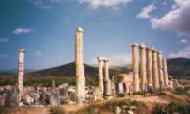The ancient city of Aphrodisias, dedicated to the goddess of love Aphrodite, was a Hellenistic city which also flourished under Roman and Byzantine rule. Excavations in the 24-meter-high (78 feet) theater hill have revealed layers of settlement going back to the Bronze Age (around 2800-2200 BC). It was founded in the 5th c. BC and flourished under the Roman Empire (1st century BC - 4th century AD). Mark Antony recognized the autonomy of Aphrodisias in the 1st century BC. During the Byzantine period it was first the seat of an archbishopric, then of the metropolitan of Caria. In the 6th century AD the name of Aphrodisias was changed to Stavropolis, the "city of the Cross", to erase the pagan goddess of love from people's minds. As the capital of Caria, Aphrodisias was finally called Caria which then became Geyre in Turkish. Later in the 13th century it was abandoned, the city was buried by a series of earthquakes.
 Aphrodisias was primarily known as a center for the arts, specifically sculpture. The Aphrodisias School of Sculpture had a distinctive style and was very well circulated throughout the Greek and Roman world. Statues with corresponding signatures were discovered from Spain to present day Germany and virtually everywhere in the Roman world. The existence of Aphrodisias was almost forgotten until a Turkish professor, Dr. Kenan Erim, from New York University received a grant from National Geographic to excavate the site in the 1960's. His archaeological work revealed a city of vast importance.
Aphrodisias was primarily known as a center for the arts, specifically sculpture. The Aphrodisias School of Sculpture had a distinctive style and was very well circulated throughout the Greek and Roman world. Statues with corresponding signatures were discovered from Spain to present day Germany and virtually everywhere in the Roman world. The existence of Aphrodisias was almost forgotten until a Turkish professor, Dr. Kenan Erim, from New York University received a grant from National Geographic to excavate the site in the 1960's. His archaeological work revealed a city of vast importance.
 The ruins are numerous and well preserved. A two mile long Byzantine wall still surrounds the city. The Temple of Aphrodite, eventually converted to a Christian basilica, is excellently preserved. The Tetrapylon, the gate which was leading people to their great temple, was re-erected by Kenan Erim, where he's buried in front of it with a special permission of the Government after his death. The Baths of Hadrian are still partially standing. The theatre and the stadium are one of the best preserved in all eastern Mediterranean. The nearby museum contains many beautiful statues and portrait sculpture.
The ruins are numerous and well preserved. A two mile long Byzantine wall still surrounds the city. The Temple of Aphrodite, eventually converted to a Christian basilica, is excellently preserved. The Tetrapylon, the gate which was leading people to their great temple, was re-erected by Kenan Erim, where he's buried in front of it with a special permission of the Government after his death. The Baths of Hadrian are still partially standing. The theatre and the stadium are one of the best preserved in all eastern Mediterranean. The nearby museum contains many beautiful statues and portrait sculpture.
Aphrodisias today is only 1:30 hours driving from Pamukkale and around 2:15 hours drive from Ephesus. Nearby and along the road to the site there are several small restaurants where you can taste local dishes prepared especially with home made olive oil.
In 2017 Aphrodisias archaeological site has entered into the List of World Heritage Sites by UNESCO.

